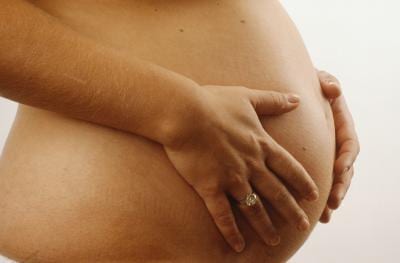During your ninth month, you are eager to hold your baby. Every time you feel the slightest twinge, you may think, “this is it,” but the feeling goes away and you realize you have longer to wait. Some mothers start labor suddenly with painful contractions, yet others begin with progressive signs, such as a backache and contractions that last for days. While each labor is different, there are typical stages that each woman goes through when her birth time is near.
Lightening or Dropping
Towards the end of pregnancy, your baby will drop deeper into your pelvis. This is known as lightening, dropping or engagement. You will normally feel the difference as the pressure increases in your pelvis and you feel like you can breathe easier. First time moms may notice this a few weeks before delivery, while second and subsequent babies may not drop until labor begins.
Increased Braxton Hicks
Braxton Hicks contractions have been happening throughout your pregnancy whether you noticed or not. These are simply toning contractions that make your uterus muscle tighten and release. As labor approaches, you may notice these toning contractions get stronger and may even become painful. These increased contractions will start to make changes to your cervix, such as dilation and effacement.
Bloody Show or Mucus
The combination of your baby’s head being low in the pelvis and the increase of contractions that are thinning the cervix can cause the mucus plug to dislodge. The mucus plug sealed the cervix for your entire pregnancy, acting as a protective barrier against potential infections. The mucus can be stringy or gooey, and it may come out in one big clump or in several small amounts over a week or two. It may be tinged with pink, brown, or reddish blood, all which are normal.
Diarrhea
It is quite common to experience diarrhea and abdominal cramps a few days to a few hours before labor begins. This is your body’s own way of cleaning out your intestines and making room for your baby to descend.
Low Backache
Low backache is very common during the onset of labor. The contracting uterus muscle pulls firmly on the back and causes discomfort. If your baby is in a posterior position, which means that the back of the baby’s head is against your spine, you may experience more discomfort than usual.
Rupture of Membranes
Although it is not common, the amniotic sac which is the sac filled with fluid surrounding your baby, may break before labor begins. When this happens, contractions normally begin within several hours. If your amniotic sac breaks before you are in the hospital, WebMD suggests paying attention to the color of the fluid, how much fluid came out when it broke and what time it happened. Your health care provider will want to know these things.
Labor Contractions
The most definite way to know you are in labor is by having consistent, rhythmic contractions. When contractions begin, you may notice them as uncomfortable cramps that are happening every now and then. As time progresses, they become much more painful, require your attention, and happen more frequently. If you are birthing in a hospital or birthing center, you should make plans to go when your contractions are five minutes apart, lasting a minute long and have been consistent for an hour.





